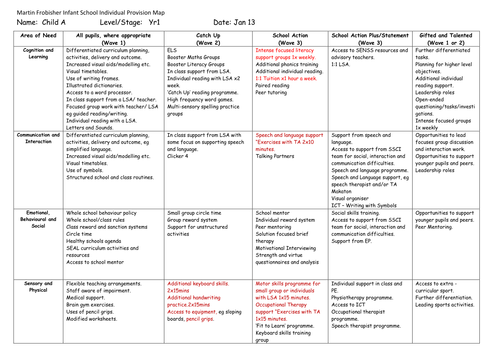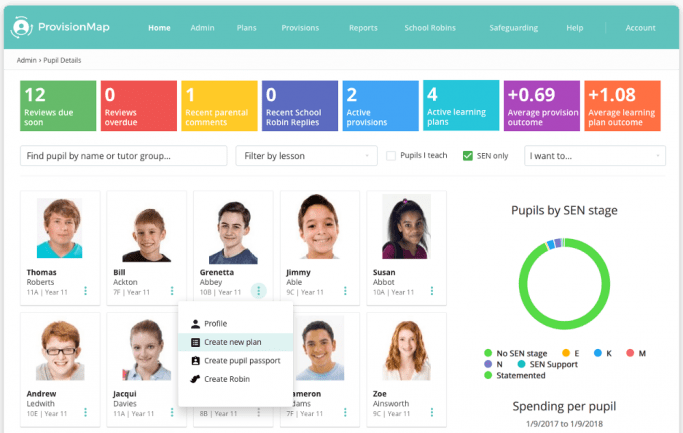Provision Mapping: Tracking SEND Support Effectively
Complete 2025 guide to Provision Maps for UK schools. SEND intervention tracking, digital tools, and best practices for SENCOs and school leaders.


Complete 2025 guide to Provision Maps for UK schools. SEND intervention tracking, digital tools, and best practices for SENCOs and school leaders.
A provision map is a way to show and document the types of interventions, support and additional staffing offered to the learners at an educational setting that is different from and additional to the ones offered via the school’s differentiated curriculum. These tools offer key staff an insight into the provision and an overview of the children who need extra support. It is a challenge for senior staff to keep tabs on what interventions are being facilitated to ensure inclusion across the curriculum. These devices don't need to be complex, a simple provision map template similar to a timetable can ensure suitable levels of provision across the school.
Provision maps allow schools to look strategically at their pupils' needs, including inclusive education for those belonging to underprivileged groups, to identify their needs and strengths. Then it can be made possible to plan provisions to fulfil their needs and to track individual pupils progress to enhance learning outcomes. Any additional funding coming into school has to be accounted for and these types of mechanisms can also act as an accountability measure.
A provision map ensures the entitlement of each student and increases standards and achievement. An effective provision of resources shows a clear connection between current provision and student progress. Provision maps may also involve each of the key staff and can be vital to the whole-school planning and development process.
Schools can use provision maps in several ways to support and inform their improvement plan. Usually, in the form of a piece of software, they provide teachers with a way of managing the key resources. One of the main uses of provision maps is to track the progress of individual pupils. By using data and assessment information, teachers can identify areas where a student may need additional support or intervention. The provision map can then be used to plan and monitor the provision that is put in place to help the student achieve their targets. This can be especially useful for pupils with special educational needs or those who require additional support to reach their full potential.
Their uses can include:

Provision maps can document the variety of additional support, staffing and provision. The first type of provision map is one created by the school's Provision Map Writer. This map is used to identify the needs of individual students and to plan the appropriate support and interventions required to meet those needs. It is a collaborative effort between teachers, parents, and other professionals involved in the student's education.
The Provision Map Writer is responsible for ensuring that the map is regularly reviewed and updated to reflect progress and changes in the student's needs. This type of provision map is an essential tool for ensuring that students receive the support they need to reach their full potential.
They can be drawn up according to:
Provision mapping includes the full spectrum of provision, taking into account a superior whole class teaching, supervised and group work and personalized interventions to identify and remove potential difficulties in learning and meeting the needs of all children inside and beyond the school setting.
An effective provision map includes the following six steps:
Step 1. Investigate the projected needs of the school: At this stage, the school will audit and document the current provision and identify the allocated range of resources. This can be done for a specific vulnerable cohort, for a specific group or each child under a class base, key stage or year group. The school will collect information from students, teachers, parents and other supporting entities to identify and evaluate the target groups. Their requirements can be categorized on a must/could/ should help basis.
Step 2. Comparison of the school's current provision with the projected needs and identification of staff development needs: Comparison of current provision with the projected needs might highlight specific areas of concern; for instance, a specific class or group of students at special schools. Also, it may raise awareness of a specific group that is not as well supported as others. After identifying specific areas or groups of concern, it is possible to address the specific staff training needs: Staff development planning will involve:

Step 3. Identification of the available resources: Assessment of the available catch-up funding to check whether the school may use funding streams to supply provision to the entire school.
Step 4. Planning the provision map for the upcoming year after reviewing the evidence of what worked: Review effectiveness of interventions.
Step 5. Identification of the processes and criteria for monitoring and tracking pupils’ progress:
Analyzing the current provision in place and whether the tracking protocol measures both large and small steps in provision management progress.
Step 6. Creating systems to analyze the effectiveness of provision: It is suggested to consider questions like:

To increase the effectiveness of provision map writer, a school needs to:
A provision map provides a great way to express and document the types of interventions, support and additional staffing offered to the pupils at an educational setting, that is different from and additional to the ones already delivered via the school’s differentiated curriculum. Provision maps helps schools to look strategically at their learners' specific needs, including inclusive education for those belonging to underprivileged groups, to identify their strengths and weaknesses. Schools may create a new provision map document or they may use a provision mapping tool such as an online/ free /paid provision map template designed to help provision map writers with the provision management in an educational setting. Considering the school staff workload, schools may decide to use a blank provision map / template provision map / provision mapping software for schools, that would be used by the independent education consultant or a key staff to show what has been done and what is still needs to be done at an educational setting.

Provision maps help schools track interventions and support for pupils with additional needs.
A provision map is a strategic tool that documents and tracks interventions, support, and additional staffing offered to learners that goes beyond the school's standard differentiated curriculum. Unlike regular classroom support, it specifically focuses on additional provisions for pupils with SEND or those needing extra help, providing senior staff with a clear overview of who receives what support and when.
Start by investigating your school's projected needs through auditing current provision and gathering information from students, teachers, and parents. Then compare current provision with identified needs, assess available resources and funding, plan interventions based on evidence of what works, establish monitoring criteria for tracking progress, and finally create systems to analyse the effectiveness of your provision.
Provision maps serve as an accountability shield during Ofsted inspections by demonstrating clear value for money and tracking of additional funding such as pupil premium. They help identify gaps in provision, prevent overlapping interventions, and create a strategic connection between current support and pupil progress, ultimately transforming whole-school approaches to supporting vulnerable learners.
Provision maps allow teachers to use data and assessment information to identify specific areas where students need additional support or intervention. They provide a systematic way to plan, monitor, and document the provision put in place for each pupil, making it especially valuable for tracking progress of pupils with special educational needs towards their individual targets.
Schools can organise provision maps by key stage, year group, or class base, or focus on specific areas like SEND, whole-school inclusion, or additional needs. They can also be structured by cost per provision or child, organised around the four main areas of need from the SEN code of practice, or designed as a mixture of approaches to suit the school's particular requirements.
Schools often struggle with keeping provision maps simple and manageable rather than overly complex documentation exercises. The key is to use straightforward templates similar to timetables and focus on creating clear connections between provision and pupil progress rather than just completing paperwork for compliance purposes.
Provision maps provide clear documentation of how additional funding streams are allocated and used across the school, showing direct links between financial investment and student outcomes. They help schools evaluate the cost-effectiveness of interventions, identify where resources may be duplicated or inappropriate, and demonstrate to stakeholders including parents and external agencies that funding is being used strategically to support pupil progress.
Here are five key studies on the use and impact of provision maps in schools for targeting and enhancing provision for pupils, particularly focusing on pupil progress, provision types, and administrative efficiency:
These studies collectively showcase the effectiveness of provision maps in improving pupil progress, optimizing administrative time, and providing a clear evidence base for diverse provision types in educational settings.
A provision map is a way to show and document the types of interventions, support and additional staffing offered to the learners at an educational setting that is different from and additional to the ones offered via the school’s differentiated curriculum. These tools offer key staff an insight into the provision and an overview of the children who need extra support. It is a challenge for senior staff to keep tabs on what interventions are being facilitated to ensure inclusion across the curriculum. These devices don't need to be complex, a simple provision map template similar to a timetable can ensure suitable levels of provision across the school.
Provision maps allow schools to look strategically at their pupils' needs, including inclusive education for those belonging to underprivileged groups, to identify their needs and strengths. Then it can be made possible to plan provisions to fulfil their needs and to track individual pupils progress to enhance learning outcomes. Any additional funding coming into school has to be accounted for and these types of mechanisms can also act as an accountability measure.
A provision map ensures the entitlement of each student and increases standards and achievement. An effective provision of resources shows a clear connection between current provision and student progress. Provision maps may also involve each of the key staff and can be vital to the whole-school planning and development process.
Schools can use provision maps in several ways to support and inform their improvement plan. Usually, in the form of a piece of software, they provide teachers with a way of managing the key resources. One of the main uses of provision maps is to track the progress of individual pupils. By using data and assessment information, teachers can identify areas where a student may need additional support or intervention. The provision map can then be used to plan and monitor the provision that is put in place to help the student achieve their targets. This can be especially useful for pupils with special educational needs or those who require additional support to reach their full potential.
Their uses can include:

Provision maps can document the variety of additional support, staffing and provision. The first type of provision map is one created by the school's Provision Map Writer. This map is used to identify the needs of individual students and to plan the appropriate support and interventions required to meet those needs. It is a collaborative effort between teachers, parents, and other professionals involved in the student's education.
The Provision Map Writer is responsible for ensuring that the map is regularly reviewed and updated to reflect progress and changes in the student's needs. This type of provision map is an essential tool for ensuring that students receive the support they need to reach their full potential.
They can be drawn up according to:
Provision mapping includes the full spectrum of provision, taking into account a superior whole class teaching, supervised and group work and personalized interventions to identify and remove potential difficulties in learning and meeting the needs of all children inside and beyond the school setting.
An effective provision map includes the following six steps:
Step 1. Investigate the projected needs of the school: At this stage, the school will audit and document the current provision and identify the allocated range of resources. This can be done for a specific vulnerable cohort, for a specific group or each child under a class base, key stage or year group. The school will collect information from students, teachers, parents and other supporting entities to identify and evaluate the target groups. Their requirements can be categorized on a must/could/ should help basis.
Step 2. Comparison of the school's current provision with the projected needs and identification of staff development needs: Comparison of current provision with the projected needs might highlight specific areas of concern; for instance, a specific class or group of students at special schools. Also, it may raise awareness of a specific group that is not as well supported as others. After identifying specific areas or groups of concern, it is possible to address the specific staff training needs: Staff development planning will involve:

Step 3. Identification of the available resources: Assessment of the available catch-up funding to check whether the school may use funding streams to supply provision to the entire school.
Step 4. Planning the provision map for the upcoming year after reviewing the evidence of what worked: Review effectiveness of interventions.
Step 5. Identification of the processes and criteria for monitoring and tracking pupils’ progress:
Analyzing the current provision in place and whether the tracking protocol measures both large and small steps in provision management progress.
Step 6. Creating systems to analyze the effectiveness of provision: It is suggested to consider questions like:

To increase the effectiveness of provision map writer, a school needs to:
A provision map provides a great way to express and document the types of interventions, support and additional staffing offered to the pupils at an educational setting, that is different from and additional to the ones already delivered via the school’s differentiated curriculum. Provision maps helps schools to look strategically at their learners' specific needs, including inclusive education for those belonging to underprivileged groups, to identify their strengths and weaknesses. Schools may create a new provision map document or they may use a provision mapping tool such as an online/ free /paid provision map template designed to help provision map writers with the provision management in an educational setting. Considering the school staff workload, schools may decide to use a blank provision map / template provision map / provision mapping software for schools, that would be used by the independent education consultant or a key staff to show what has been done and what is still needs to be done at an educational setting.

Provision maps help schools track interventions and support for pupils with additional needs.
A provision map is a strategic tool that documents and tracks interventions, support, and additional staffing offered to learners that goes beyond the school's standard differentiated curriculum. Unlike regular classroom support, it specifically focuses on additional provisions for pupils with SEND or those needing extra help, providing senior staff with a clear overview of who receives what support and when.
Start by investigating your school's projected needs through auditing current provision and gathering information from students, teachers, and parents. Then compare current provision with identified needs, assess available resources and funding, plan interventions based on evidence of what works, establish monitoring criteria for tracking progress, and finally create systems to analyse the effectiveness of your provision.
Provision maps serve as an accountability shield during Ofsted inspections by demonstrating clear value for money and tracking of additional funding such as pupil premium. They help identify gaps in provision, prevent overlapping interventions, and create a strategic connection between current support and pupil progress, ultimately transforming whole-school approaches to supporting vulnerable learners.
Provision maps allow teachers to use data and assessment information to identify specific areas where students need additional support or intervention. They provide a systematic way to plan, monitor, and document the provision put in place for each pupil, making it especially valuable for tracking progress of pupils with special educational needs towards their individual targets.
Schools can organise provision maps by key stage, year group, or class base, or focus on specific areas like SEND, whole-school inclusion, or additional needs. They can also be structured by cost per provision or child, organised around the four main areas of need from the SEN code of practice, or designed as a mixture of approaches to suit the school's particular requirements.
Schools often struggle with keeping provision maps simple and manageable rather than overly complex documentation exercises. The key is to use straightforward templates similar to timetables and focus on creating clear connections between provision and pupil progress rather than just completing paperwork for compliance purposes.
Provision maps provide clear documentation of how additional funding streams are allocated and used across the school, showing direct links between financial investment and student outcomes. They help schools evaluate the cost-effectiveness of interventions, identify where resources may be duplicated or inappropriate, and demonstrate to stakeholders including parents and external agencies that funding is being used strategically to support pupil progress.
Here are five key studies on the use and impact of provision maps in schools for targeting and enhancing provision for pupils, particularly focusing on pupil progress, provision types, and administrative efficiency:
These studies collectively showcase the effectiveness of provision maps in improving pupil progress, optimizing administrative time, and providing a clear evidence base for diverse provision types in educational settings.